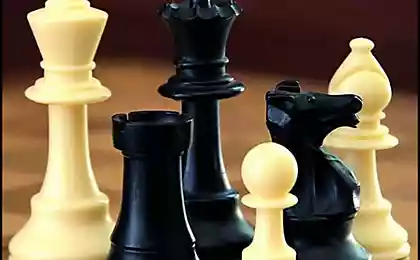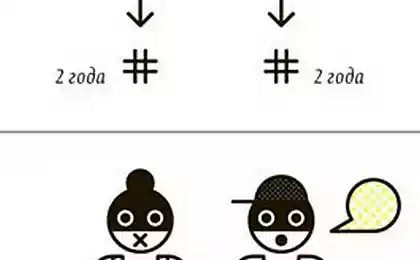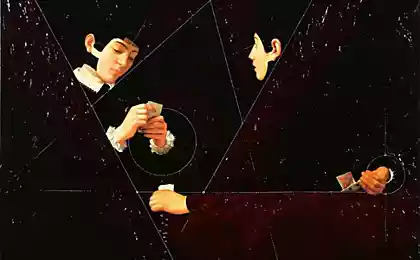602
Game theory: 5 simple examples of popular game strategies
To get around an opponent — that's what it takes to win in any game. But how to do it? Here you will find the answer.
Game theory concerns itself with ways to make the best move and get a bigger piece of the winning pie, chop off part of it from other players. It teaches you to analyze a variety of factors and make a balanced logical conclusions. I think it needs to be studied after the numbers to the alphabet. Just because too many people take important decisions based on intuition, the secret prophecy, the position of the stars and other such. I have carefully examined the theory of games, and now I want to tell you about its basics. It could possibly add common sense to your life.
1. The prisoner's dilemmaBerto and Robert was arrested for Bank robbery, failing to correctly use to escape a stolen vehicle. The police can't prove they robbed the Bank, but caught them red-handed in a stolen car. They were taken to different rooms and each offered a deal: to your accomplice and send him behind bars for 10 years, and to go free. But if they both rat each other out, you each get 7 years. If no one will say anything, both of you will sit for 2 years just for stealing a car.

It turns out that if Berto is silent, but Robert passes it, he goes to jail for 10 years, and Robert was released.
Every prisoner is a player, and the benefits of each can be presented in the form of "formulas" (that'll get both of them that I will get the other). For example, if I hit you, my winning scheme will look like this (I get a rough victory, you suffer from severe pain). Because each prisoner has two options, we can present the results in a table.
Practical application: Identifying sociopolises we see the main application of game theory: identifying sociopaths who think only of themselves. Real game theory is a powerful analytical tool, and inexperience often serves as a red flag, with the outstanding head of a man without a concept of honor. The people doing the calculations intuitively believe that it is better to do the ugly, because it will lead to a shorter prison term regardless of what the other player. Technically this is correct, but only if you short-sighted person putting up the numbers above human lives. That is why theory is so popular in the field of Finance.
The real problem is a prisoner's dilemma in that it ignores the data. For example, it does not consider the possibility of your meeting with your friends, relatives or even creditors of the person you put in jail for 10 years.
The worst thing is that all participants in a prisoner's dilemma act as if they had never heard of her.
And the best move is to remain silent, and two years later, together with a good friend shared money.
2. The dominant strategyIs the situation where your actions provide the greatest payoff, regardless of the actions of the opponent. Whatever happens — you did the right thing. This is why many people in the "prisoner's dilemma" consider: act of betrayal leads to a "better" result no matter what the other fellow does, while ignoring the reality inherent in this method, makes everything look super-simple.
Most of the games we play, has no strictly dominant strategies, because otherwise they would be just awful. Imagine that you would ever do the same. In the game "rock-scissors-paper" there is no dominant strategy. But if you were playing with a man, whose hands wearing oven mitts, and he could only show stone or paper, you would have a dominant strategy: paper. Your paper will wrap the stone or it will lead to a draw, and you can't lose, because the opponent can not show the scissors. Now, when you have a dominant strategy, you have to be a fool to try something different.
3. Battle of the sexesGame more interesting when they have no strictly dominant strategy. For example, the battle of the sexes. Anjali and Borislav go on a date, but I can't choose between ballet and Boxing. Anjali loves Boxing because she likes it when blood flows to the delight of the screaming crowd, who consider themselves civilized just because they paid for someone's broken heads.
Borislav wants to watch the ballet because he understands that ballerinas go through a huge number of injuries and challenging workouts, knowing that one injury could put an end to all. Ballet dancers — the greatest athletes on Earth. The dancer can hit you with a foot to the head, but will never do it, because her leg is worth much more than your face.
Each of them wants to go to their favorite event, but they don't want to enjoy it alone, thus, we obtain the diagram prize: the highest value — to do what they like, the smallest value of just being with another person, and zero — to be alone.
Some people offer to stubbornly teeter on the brink of war: if you no matter what, do what you want, the other person should adapt to your choices or lose everything. As I said, a simplified theory of games perfectly brings out the stupid.
Practical application: avoid sharp ploucnice, and this strategy has its considerable drawbacks. First of all, if you treat your dates as "battle of the sexes", it won't work. Break that each of you could find someone who he likes. A second problem is that in this situation participants are not so confident that can't do that.
Truly a winning strategy for everyone to do what they want, and after, or the next day, when they will be free to go along to the cafe. Or alternate between Boxing and ballet, while in the world of entertainment, not a revolution and never will be invented a Boxing ballet.
4. Nash equilibriuma Nash Equilibrium is a set of moves where no one else wants to do something differently after the fact. And if we can make this work, game theory replaces the entire philosophical, religious, and financial system on the planet, because "the desire not to fail" has become for humanity a more potent driving force than fire.
Let's quickly divide the$ 100. You and I will decide how much of the hundreds we require and at the same time voiced amount. If our total less than a hundred, everyone gets what they wanted. If the total number of more than a hundred, the one who asked the least amount, gets the desired amount, and more than a greedy man gets what is left. If we ask the same amount, everyone gets 50 $. How much you ask? How you divide the money? There is only one winning move.
Requirement 51 $ will give you the maximum amount regardless of what choose your opponent. If he asks for more, you will receive 51 $. If he asks for 50 $ 51 or $, you'll get $ 50. And if he asks for less than 50 $, you will receive 51 $. In any case, there is no other option that will bring you more money than this. Nash equilibrium — a situation where we both pick the 51 $.
Practical application: first Gumilev this is the essence of game theory. Not necessarily win, and especially to harm other players, but be sure to make the best move, regardless of what will prepare you for the surrounding. And even better, if this move will be beneficial for other players. Perhaps that could change society.
An interesting variant of this idea is drinking alcohol, which can be called a Nash Equilibrium time-dependent. When you drink enough, you don't care about the actions of others no matter what they do, but the next day you really regret not having acted differently.
5. Toss a coinIn the toss involving Player 1 and Player 2. Each player simultaneously chooses heads or tails. If they guess right, Player 1 receives Player 2 pence. If not, Player 2 gets the coin Player 1.
Winning the matrix is simple...
...the optimal strategy: play completely at random. It's harder than you think, because the choice must be completely random. If you have a preference heads or tails, the opponent can use it to take your money.
Of course, the real problem here is that it would be much better if they just threw a penny into each other. As a result, their profit would be the same, and the injury could help these unfortunate people to feel something other than terrible boredom. After all, this is the worst game of available ever. And this is the perfect model for penalties.
Practical application: Penalty football, hockey and many other games, the extra time — a penalty shootout. And they would have been more interesting if it was based on how many times the players in full uniform will be able to make a "wheel" because it is, at least, would be an indicator of their physical abilities and it would be fun to watch. Goalkeepers can not clearly determine the movement of the ball or puck at the beginning of their movement, because, unfortunately, in our sports robots are still not participating. The goalkeeper needs to choose the left or right direction and hope that his choice coincides with the choice of opponent will hit a shot. This has something in common with the game in a coin.
However, please note that this not a perfect example of similarities with the game of eagle and tails, because even with proper choice of the direction of the goalkeeper can not catch the ball, and the striker may not be on target.
So what is our conclusion according to game theory? Ball games must end by way of "multimate" where every minute players one-on-one is added to the ball/puck, to one of the parties receives a certain result, which was an indicator of real skill players, not spectacular coincidence.
In the end, game theory must be used in order to make the game smarter. And that means better. published
Translation of the article, Luke McKinney of the popular American blog Cracked.
P. S. And remember, only by changing their consumption — together we change the world! ©
Source: www.factroom.ru/science/game-theory?utm_source=post&utm_campaign=relposts
Game theory concerns itself with ways to make the best move and get a bigger piece of the winning pie, chop off part of it from other players. It teaches you to analyze a variety of factors and make a balanced logical conclusions. I think it needs to be studied after the numbers to the alphabet. Just because too many people take important decisions based on intuition, the secret prophecy, the position of the stars and other such. I have carefully examined the theory of games, and now I want to tell you about its basics. It could possibly add common sense to your life.

1. The prisoner's dilemmaBerto and Robert was arrested for Bank robbery, failing to correctly use to escape a stolen vehicle. The police can't prove they robbed the Bank, but caught them red-handed in a stolen car. They were taken to different rooms and each offered a deal: to your accomplice and send him behind bars for 10 years, and to go free. But if they both rat each other out, you each get 7 years. If no one will say anything, both of you will sit for 2 years just for stealing a car.

It turns out that if Berto is silent, but Robert passes it, he goes to jail for 10 years, and Robert was released.
Every prisoner is a player, and the benefits of each can be presented in the form of "formulas" (that'll get both of them that I will get the other). For example, if I hit you, my winning scheme will look like this (I get a rough victory, you suffer from severe pain). Because each prisoner has two options, we can present the results in a table.
Practical application: Identifying sociopolises we see the main application of game theory: identifying sociopaths who think only of themselves. Real game theory is a powerful analytical tool, and inexperience often serves as a red flag, with the outstanding head of a man without a concept of honor. The people doing the calculations intuitively believe that it is better to do the ugly, because it will lead to a shorter prison term regardless of what the other player. Technically this is correct, but only if you short-sighted person putting up the numbers above human lives. That is why theory is so popular in the field of Finance.
The real problem is a prisoner's dilemma in that it ignores the data. For example, it does not consider the possibility of your meeting with your friends, relatives or even creditors of the person you put in jail for 10 years.
The worst thing is that all participants in a prisoner's dilemma act as if they had never heard of her.
And the best move is to remain silent, and two years later, together with a good friend shared money.
2. The dominant strategyIs the situation where your actions provide the greatest payoff, regardless of the actions of the opponent. Whatever happens — you did the right thing. This is why many people in the "prisoner's dilemma" consider: act of betrayal leads to a "better" result no matter what the other fellow does, while ignoring the reality inherent in this method, makes everything look super-simple.
Most of the games we play, has no strictly dominant strategies, because otherwise they would be just awful. Imagine that you would ever do the same. In the game "rock-scissors-paper" there is no dominant strategy. But if you were playing with a man, whose hands wearing oven mitts, and he could only show stone or paper, you would have a dominant strategy: paper. Your paper will wrap the stone or it will lead to a draw, and you can't lose, because the opponent can not show the scissors. Now, when you have a dominant strategy, you have to be a fool to try something different.
3. Battle of the sexesGame more interesting when they have no strictly dominant strategy. For example, the battle of the sexes. Anjali and Borislav go on a date, but I can't choose between ballet and Boxing. Anjali loves Boxing because she likes it when blood flows to the delight of the screaming crowd, who consider themselves civilized just because they paid for someone's broken heads.
Borislav wants to watch the ballet because he understands that ballerinas go through a huge number of injuries and challenging workouts, knowing that one injury could put an end to all. Ballet dancers — the greatest athletes on Earth. The dancer can hit you with a foot to the head, but will never do it, because her leg is worth much more than your face.
Each of them wants to go to their favorite event, but they don't want to enjoy it alone, thus, we obtain the diagram prize: the highest value — to do what they like, the smallest value of just being with another person, and zero — to be alone.
Some people offer to stubbornly teeter on the brink of war: if you no matter what, do what you want, the other person should adapt to your choices or lose everything. As I said, a simplified theory of games perfectly brings out the stupid.
Practical application: avoid sharp ploucnice, and this strategy has its considerable drawbacks. First of all, if you treat your dates as "battle of the sexes", it won't work. Break that each of you could find someone who he likes. A second problem is that in this situation participants are not so confident that can't do that.
Truly a winning strategy for everyone to do what they want, and after, or the next day, when they will be free to go along to the cafe. Or alternate between Boxing and ballet, while in the world of entertainment, not a revolution and never will be invented a Boxing ballet.
4. Nash equilibriuma Nash Equilibrium is a set of moves where no one else wants to do something differently after the fact. And if we can make this work, game theory replaces the entire philosophical, religious, and financial system on the planet, because "the desire not to fail" has become for humanity a more potent driving force than fire.
Let's quickly divide the$ 100. You and I will decide how much of the hundreds we require and at the same time voiced amount. If our total less than a hundred, everyone gets what they wanted. If the total number of more than a hundred, the one who asked the least amount, gets the desired amount, and more than a greedy man gets what is left. If we ask the same amount, everyone gets 50 $. How much you ask? How you divide the money? There is only one winning move.
Requirement 51 $ will give you the maximum amount regardless of what choose your opponent. If he asks for more, you will receive 51 $. If he asks for 50 $ 51 or $, you'll get $ 50. And if he asks for less than 50 $, you will receive 51 $. In any case, there is no other option that will bring you more money than this. Nash equilibrium — a situation where we both pick the 51 $.
Practical application: first Gumilev this is the essence of game theory. Not necessarily win, and especially to harm other players, but be sure to make the best move, regardless of what will prepare you for the surrounding. And even better, if this move will be beneficial for other players. Perhaps that could change society.
An interesting variant of this idea is drinking alcohol, which can be called a Nash Equilibrium time-dependent. When you drink enough, you don't care about the actions of others no matter what they do, but the next day you really regret not having acted differently.
5. Toss a coinIn the toss involving Player 1 and Player 2. Each player simultaneously chooses heads or tails. If they guess right, Player 1 receives Player 2 pence. If not, Player 2 gets the coin Player 1.
Winning the matrix is simple...
...the optimal strategy: play completely at random. It's harder than you think, because the choice must be completely random. If you have a preference heads or tails, the opponent can use it to take your money.
Of course, the real problem here is that it would be much better if they just threw a penny into each other. As a result, their profit would be the same, and the injury could help these unfortunate people to feel something other than terrible boredom. After all, this is the worst game of available ever. And this is the perfect model for penalties.
Practical application: Penalty football, hockey and many other games, the extra time — a penalty shootout. And they would have been more interesting if it was based on how many times the players in full uniform will be able to make a "wheel" because it is, at least, would be an indicator of their physical abilities and it would be fun to watch. Goalkeepers can not clearly determine the movement of the ball or puck at the beginning of their movement, because, unfortunately, in our sports robots are still not participating. The goalkeeper needs to choose the left or right direction and hope that his choice coincides with the choice of opponent will hit a shot. This has something in common with the game in a coin.
However, please note that this not a perfect example of similarities with the game of eagle and tails, because even with proper choice of the direction of the goalkeeper can not catch the ball, and the striker may not be on target.
So what is our conclusion according to game theory? Ball games must end by way of "multimate" where every minute players one-on-one is added to the ball/puck, to one of the parties receives a certain result, which was an indicator of real skill players, not spectacular coincidence.
In the end, game theory must be used in order to make the game smarter. And that means better. published
Translation of the article, Luke McKinney of the popular American blog Cracked.
P. S. And remember, only by changing their consumption — together we change the world! ©
Source: www.factroom.ru/science/game-theory?utm_source=post&utm_campaign=relposts























